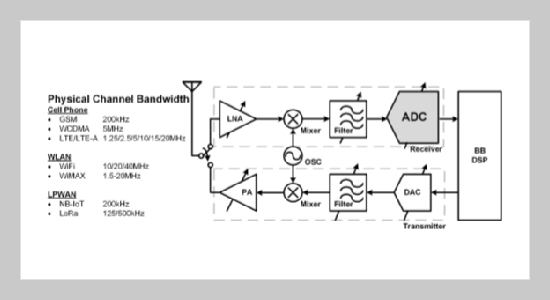REFERENCES
- [1] R Bagheri, A Mirzaei, ME Heidari, S Chehrazi, M Lee, M Mikhemar, WK Tang, and AA Abidi. Softwaredefined radio receiver: dream to reality. IEEE Communications Magazine, pages 111–118, 2006.
- [2] Hossam Fattah. 5G LTE Narrowband Internet of Things (NB-IoT). 2018.
- [3] Andrea Baschirotto, Fabio Campi, Rinaldo Castello, Giovanni Cesura, Giovanni Cesura, Mario Toma, Roberte Guerrieri, Andrea Lodi, Luciano Lavagno, and PieroMalcovati. Baseband analog front-end and digital back-end for reconfigurable multi-standard terminals. IEEE Circuits and Systems Magazine, 6(1):8–28, 2006.
- [4] Alonso Morgado, Rocío Del Río, and José M. Dela Rosa. High-efficiency cascade Σ∆ modulators for the next generation software-defined-radio mobile systems. IEEE Transactions on Instrumentation and Measurement, 61(11):2860–2869, 2012.
- [5] GGomezandBHaroun. A1.5V2.4/2.9mW79/50dB Sigma Delta modulator for GSM/WCDMA in a 0.13 mu digital process. IEEE Proceedings ISSCC, 2002.
- [6] A Dezzani and E Andre. A 1.2-V dual-mode WCDMA/GPRS Sigma Delta modulator. IEEE Proceedings ISSCC, 2003.
- [7] J Yu and F Maloberti. A low-power multi-bit sigma delta modulator in 90-nm digital CMOS without DEM. IEEE Proceedings ISSCC, 2005.
- [8] Ana Rusu, Delia Rodríguez de Llera González, and Mohammed Ismail. ReconfigurableADCsenablesmart radios for 4G wireless connectivity. IEEE Circuits and Devices Magazine, 22(3):6–11, 2006.
- [9] T Christen, T Burger, and Q Huang. A 0.13 um CMOS EDGE/UMTS/WLAN Tri-Mode Delta Sigma ADC with-92dB THD. IEEE Proceedings ISSCC, 2007.
- [10] AlonsoMorgado, RocíodelRío, andMJosé. AnAdaptive Σ∆ modulator for multi-standard hand-held wireless devices. In 2007 IEEE Asian Solid-State Circuits Conference, pages 232–235. IEEE, 2007.
- [11] Lynn Bos, Gerd Vandersteen, Pieter Rombouts, Arnd Geis, AlonsoMorgado, YvesRolain, GeertVanDerPlas, and Julien Ryckaert. Multirate cascaded discrete-time low-pass ∆Σ modulator for GSM/Bluetooth/UMTS. IEEE Journal of Solid-State Circuits, 45(6):1198–1208, 2010.
- [12] L Bettini, T Christen, DK Su, T Burger, and Q Huang. A Reconfigurable DT Modulator for Multi-Standard 2G/3G/4G Wireless Receivers. IEEE Journal of SolidState Circuits, 5(4):525–536, 2015.
- [13] Yi Ke, Georges Gielen, and Jan Craninckx. A Design Approach for Power-Optimized Fully Reconfigurable AE A/D Converter for 4G Radios. IEEE Transactions on Circuits and Systems II: Express Briefs, 55(3):229–233, 2008.
- [14] J Li, R Zhu, T Yi, B Liu, and Z Hong. An energy efficient 5-MHz to 20-MHz, 12-bit reconfigurable continuous-time Σ∆ modulator for 4G-LTE application. Proc. IEEE Int. Sym. Low Power Electron Design, pages 163 – 168, 2013.
- [15] Ken Xu, Min Cai, Elias H. Dagher, Bin Xu, Wesley K. Masenten, Hui Ye, Mo Huang, and Xiao Yong He. A 10.2 mW multi-mode continuous-time ∆Σ ADC with 70–87 dB DR and 0.7–10 MHz bandwidth for TDSCDMA and LTE digital receivers. Analog Integrated Circuits and Signal Processing, 89(2):395–410, nov 2016.
- [16] J. Gerardo García-Sánchez and José M. De La Rosa. Efficient hybrid continuous-time/discrete-timecascade Σ∆ modulators for wideband applications. Microelectronics Journal, 45(10):1234–1246, 2014.
- [17] Tai Haur Kuo, Kuan Dar Chen, and Jhy Rong Chen. Automatic coefficients design for high-order sigmadelta modulators. IEEE Transactions on Circuits and Systems II: Analog and Digital Signal Processing, 46(1):6– 15, 1999.
- [18] Ovidiu Bajdechi. Systematic Design of Sigma-Delta Analog-to-Digital Converters. In Analog Circuit Design, pages 293–326. Springer US, 2004.
- [19] A Marques, V Peluso, MS Steyaert, and WM Sansen. Optimal Parameters for ∆Σ Modulator Topologies. IEEE Transactions on Circuits and Systems II, 45(9):1232– 1241, 1998.
- [20] P Malcovati, S Brigati, F Francesconi, F Medeiro, and PCusinato. Behavioral modeling of switched-capacitor sigma-delta modulators. IEEE Transactions on Circuits and Systems I, 50(3):352–364, 2003.
- [21] Richard Schreier and Gabor C Temes. Understanding Delta-Sigma Data Converters. Technical report, 2005.
- [22] J Ruiz-Amaya, JM De La Rosa, FV Fernandez, FMedeiro, RDelRio, BPerez-Verdu, and A Rodriguez Vazquez. High-level synthesis of switched-capacitor, switched-current and continuous-time Sigma Delta modulators using SIMULINK-based time-domain behavioral. IEEE Transactions on Circuits and Systems I, 52(9):1795–1810, 2005.
- [23] GeorgeSúarez, ManuelJienez, andFélixO. Fernandez. Behavioral modeling methods for switched-capacitor ∆ modulators. IEEE Transactions on Circuits and Systems I: Regular Papers, 54(6):1236–1244, 2007.
- [24] Uma Chilakapati and Terri S. Fiez. Effect of switch resistance on the SC integrator settling time. IEEETransactions on Circuits and Systems II: Analog and Digital Signal Processing, 46(6):810–816, 1999.
- [25] Hyungil Chae. Double-sampling highpass delta sigma modulator with inherent frequency translation. IEICE Electronics Express, pages 14–20170862, 2017.
- [26] Paul J. Hurst and William J. McIntyre. Double sampling in switched-capacitor delta-sigma A/D converters. In Proceedings - IEEE International Symposium on Circuits and Systems, volume 2, pages 902–905, 1990.
- [27] TV Burmas, KC Dyer, PJ Husrt, and Lewis SH. A second-order double-sampled delta-sigma modulator using additive-error switching. IEEE Journal ofSelected Topicsin Applied Earth Observations and Remote Sensing, 31(3):284–293, 1996.
- [28] CK Thanh, SH Lewis, and PJ Hurst. A second order double-sampled delta-sigma modulator using individual-level averaging. IEEE Journal of Solid-State Circuits, 32(8):1269–1273, 1997.
- [29] D Senderowicz, G Nicollini, S Pernici, A Nagari, P Confalonieri, and C Dallavalle. Low-voltage double sampled Sigma Delta converters. IEEE Journal of SolidState Circuits, 32(12):1907–1919, 1997.
- [30] Katelijn Vleugels, Shahriar Rabii, and Bruce A. Wooley. A2.5-Vsigma-delta modulator for broadband communications applications. IEEE Journal of Solid-State Circuits, 36(12):1887–1899, 2001.
- [31] Min Gyu Kim, Gil Cho Ahn, Pavan Kumar Hanumolu, Sang Hyeon Lee, Sang Ho Kim, Seung Bin You, Jae Whui Kim, Gabor C. Temes, and Un Ku Moon. A 0.9 V 92 dB double-sampled switched-RC delta-sigma audio ADC. In IEEEJournalof Solid-StateCircuits, volume 43, pages 1195–1205, 2008.
- [32] P Rombouts, JD Maeyer, and L Weyten. Design of double-sampling Sigma Delta Modulation A/D converters with bilinear integrators. IEEETransactionson Circuits and Systems I, 52(4):715–722, 2005.
- [33] HsinLiang Chen and JenShiun Chiang. Alow-power and multi-mode design approach for reconfigurable MASH SDM. In 2009 IEEE International Conference on Integrated Circuit Design and Technology, ICICDT 2009, pages 3–6, 2009.
- [34] Thomas Christen and Qiuting Huang. A 0.13 µm CMOS0.1–20MHzbandwidth86–70dBDRmulti-mode DT ∆Σ ADC for IMT-Advanced. In 2010 Proceedings of ESSCIRC, pages 414–417. IEEE, 2010.
- [35] Alonso Morgado, Rocío del Río, José M. de la Rosa, RafaelCastro-López,and BelénPérez-Verdú. A0.13µm CMOSadaptivesigma-deltamodulatorfortriple-mode GSM/Bluetooth/UMTS applications. Microelectronics Journal, 41(5):277–290, 2010.
















